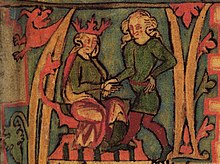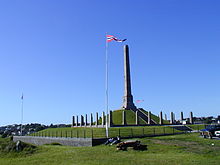| Hararld I | |
|---|---|
| King of Norway | |
 King Harald, in an illustration from the 14th century Flateyjarbók. | |
| Reign | 872–930 |
| Successor | Eirik Bloodaxe |
| Burial | |
| Spouse | Ragnhild Eriksdotter Åsa Håkonsdotter Svanhild Øysteinsdotter various concubines |
| Issue more | Eirik Bloodaxe Bjørn Farmann Olaf Geirstadalf Haakon the Good |
| Dynasty | Fairhair dynasty |
| Father | Halfdan the Black |
| Mother | Ragnhild Sigurdsdotter |
Harald Fairhair or Harald Finehair (Old Norse: Haraldr hárfagri, Norwegian: Harald Hårfagre), (c. 850 – c. 933) was the first king (872–930) of Norway.
Little is known of the historical Harald. The only contemporary sources mentioning him are the two skaldic poems Haraldskvæði and Glymdrápa, by Þorbjörn Hornklofi. The first poem describes life at Harald's court, mentions that he took a Danish wife, and that he won a victory at Hafrsfjord. The second relates a series of battles Harald has won. He is not mentioned in any contemporary foreign sources. His life was described in several of the Kings' sagas, but the first of these were not written until the end of the 12th century, over 250 years after his death. Their accounts of Harald and his life differ on several points, and much of the content is clearly mythological. He is credited with having unified Norway into one kingdom. Modern historians assume that his rule was limited to the coastal areas of southern Norway.
The saga descriptions
The sagas tell us that Harald succeeded, on the death of his father Halfdan the Black Gudrödarson, to the sovereignty of several small, and somewhat scattered kingdoms in Vestfold, which had come into his father's hands through conquest and inheritance. His protector-regent was his mother's brother Guthorm.
The unification of Norway is, according to a tale, somewhat of a love story. The tale begins with a marriage proposal that resulted in rejection and scorn from Gyda, the daughter of Eirik, king of Hordaland. She said she refused to marry Harald "before he was king over all of Norway". Harald was therefore induced to take a vow not to cut nor comb his hair until he was sole king of Norway, and that ten years later, he was justified in trimming it; whereupon he exchanged the epithet "Shockhead" or "Tanglehair" for the one by which he is usually known. Most scholars today regard this story as a literary tale inspired by the Romance stories that were popular at the courts by the time Heimskringla was written.
In 866, Harald made the first of a series of conquests over the many petty kingdoms which would compose Norway, including Värmland in Sweden, and modern day south-eastern Norway, which had sworn allegiance to the Swedish king Erik Eymundsson. In 872, after a great victory at Hafrsfjord near Stavanger, Harald found himself king over the whole country. His realm was, however, threatened by dangers from without, as large numbers of his opponents had taken refuge, not only in Iceland, then recently discovered; but also in the Orkney Islands, Shetland Islands, Hebrides Islands, Faroe Islands and the northern European mainland. However, his opponents leaving wasn't entirely voluntary. Many Norwegian chieftains who were wealthy and respected posed a threat to Harald; therefore, they were subjected to much harassment from Harald, prompting them to vacate the land. At last, Harald was forced to make an expedition to the West, to clear the islands and the Scottish mainland of some Vikings who tried to hide there.
It was long thought that Harald thus caused the Norse settlement of Iceland and beyond. According to this view, Iceland was settled by "malcontents" from Norway, who resented Harald's claim of rights of taxation over lands, which the possessors appear to have previously held in absolute ownership. This view has been largely abandoned by modern historians.
There are several accounts of large feasting mead halls constructed for important feasts when Scandinavian royalty was invited. According to a legend recorded by Snorri Sturluson, in the Heimskringla, the late 9th century Värmlandish chieftain Áki invited both the Norwegian king Harald Fairhair and the Swedish king Eric Eymundsson, but had the Norwegian king stay in the newly constructed and sumptuous one, because he was the youngest one of the kings and the one who had the greatest prospects. The older Swedish king, on the other hand, had to stay in the old feasting hall. The Swedish king was so humiliated that he killed Áki.
The Norwegian kingdoms
-
Norwegian petty kingdoms ca. 820 AD at the death of Gudrød the Hunter. The most important kingdoms were Vestfold (red), Hålogaland (purple), Alvheim (yellow) and Agder (green). -
Petty kingdoms ca. 860 AD at the death of Halfdan the Black. In red is the kingdom inherited by Harald Fairhair. -
Petty kingdoms ca. 872 AD (the unified kingdom shown in red) before the defining Battle of Hafrsfjord. -
The division of the kingdom after the Battle of Svolder (1000) between Sweden (yellow), Denmark (red) and the jarl of Lade (purple). -
Unified Norway during the reign of Saint Olav ca. 1020 AD. In pale red the Finnmarken ("Marches of the Sami") most of which paid tribute to the kings of Norway.
Later life

The latter part of Harald's reign was disturbed by the strife of his many sons. The number of sons he left varies in the different saga accounts, from 11 to 20. Twelve of his sons are named as kings, two of them over the whole country. He gave them all the royal title and assigned lands to them, which they were to govern as his representatives; but this arrangement did not put an end to the discord, which continued into the next reign. When he grew old, Harald handed over the supreme power to his favourite son Eirik Bloodaxe, whom he intended to be his successor. Eirik I ruled side-by-side with his father when Harald was 80 years old. Harald died three years later due to age in approximately 933. Harald Harfager was commonly stated to have been buried under a mound at Haugar by the Strait of Karmsund near the church in Haugesund, an area that later would be named the town and municipal Haugesund. The area near Karmsund was the traditional burial site for several early Norwegian rulers. The national monument of Haraldshaugen was raised in 1872, to commemorate the Battle of Hafrsfjord in 872.[1][2]
Issue

Harald's children with Åsa, daughter of Håkon Grjotgardsson, Earl of Lade:
- Guttorm Haraldsson, king of Ranrike
- Halvdan Kvite (Haraldsson), king of Trondheim
- Halvdan Svarte (Haraldsson), king of Trondheim.
- Sigrød Haraldsson, king of Trondheim
Children with Gyda:
- Ålov Årbot (Haraldsdotter)
- Rørek Haraldsson
- Sigtrygg Haraldsson
- Frode Haraldsson
- (Torgils Haraldsson) - identified as "Thorgest" in the Irish history. Snorri Sturluson, in his Heimskringla, claims that Torgils was Harald's son.
Children with Ragnhild Eiriksdotter of Jutland:
- Eirik Bloodaxe, king of Norway.
Children with Svanhild, daughter of Eystein Earl:
- Bjørn Farmann, king of Vestfold.
- Olaf Haraldsson Geirstadalf, king of Vingulmark, later also Vestfold.
- Ragnar Rykkel
Children with Åshild, daughter of Ring Dagsson:
- Ring Haraldsson
- Dag Haraldsson
- Gudrød Skirja
- Ingegjerd Haraldsdotter
Children with Snøfrid, daughter of Svåse the Finn:
- Halvdan Hålegg
- Gudrød Ljome
- Ragnvald Rettilbeine
- Sigurd Rise
Children with Tora Mosterstong, his maid:
- Haakon the Good, king of Norway.
Other children:
- Ingebjørg Haraldsdotter
References
- This article incorporates text from a publication now in the public domain: Chisholm, Hugh, ed. (1911). Encyclopædia Britannica (11th ed.). Cambridge University Press.
((cite encyclopedia)): Missing or empty|title=(help)
Related Reading
- Viking Empires by Angelo Forte, Richard Oram and Frederik Pedersen (Cambridge University Press. June 2005)
- The Oxford Illustrated History of the Vikings Peter Sawyer, Editor (Oxford University Press, September 2001)





